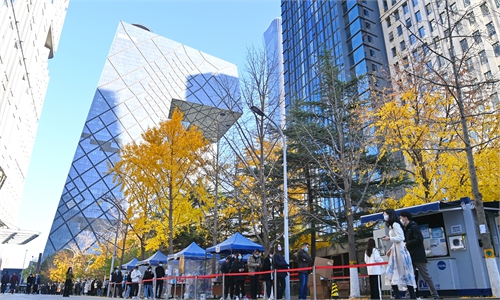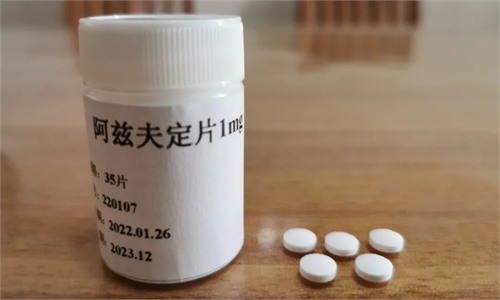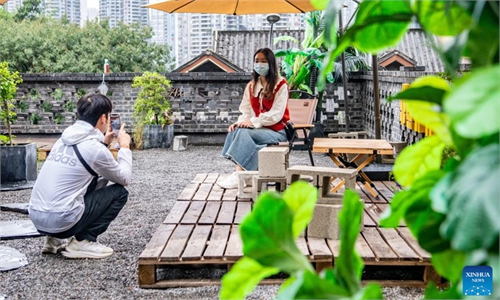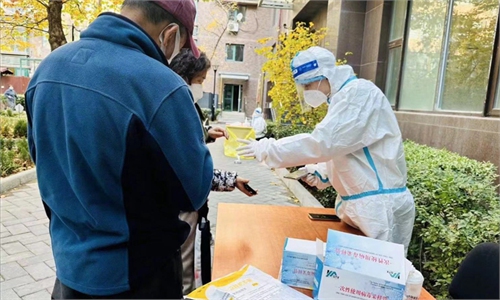Cities endeavor
to curb flare-ups
with optimized COVID measures
Bigger determination, faster speed, higher efficiency urged to win battle: official
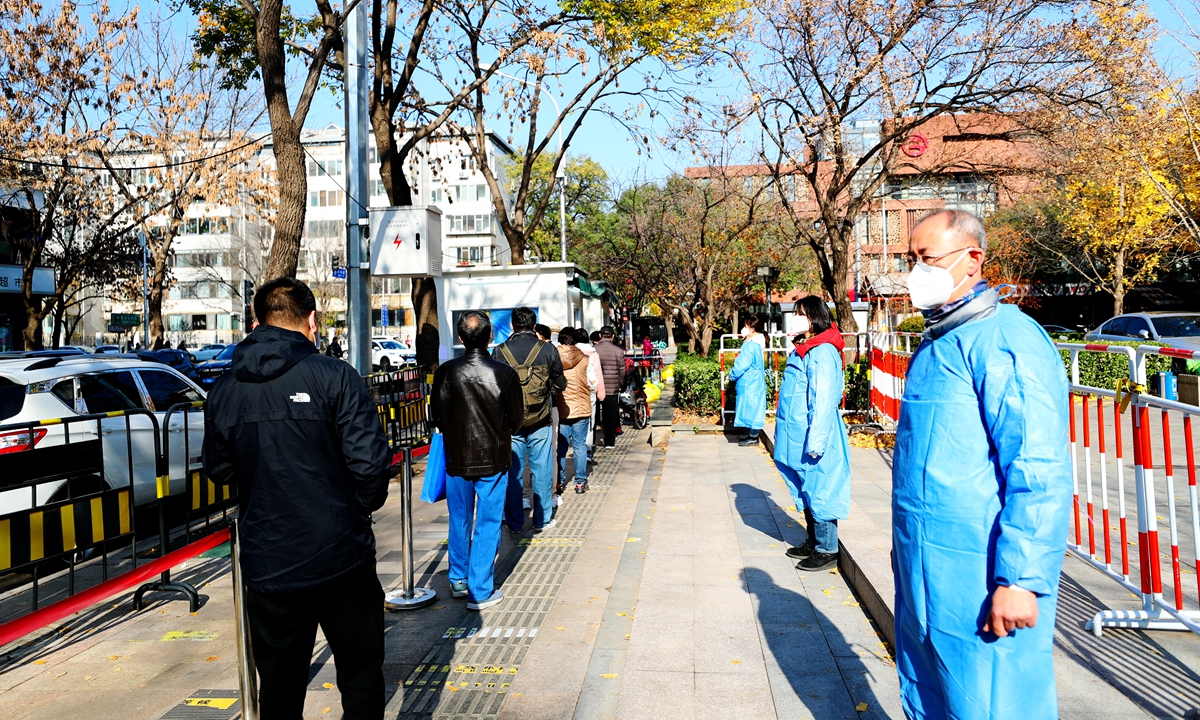
Local residents queue up to take nucleic acid tests in Beijing on November 14, 2022. Photo: IC
Several Chinese cities are battling grim COVID-19 flair-ups with rising infection cases, however, guided by the newly rolled-out 20 optimized COVID-response measures, localities are striving to minimize the impact of epidemic prevention and control brought to people's lives and economic activity, with a marathon being held in Chengdu on Sunday as scheduled.
The number of new infections nationwide in a single day has exceeded 20,000 for five days in a row. Given that the overall epidemic has a very high infection rate but low death rate, which is different from the situation at the beginning of the epidemic, epidemiologists said local strategies should adapt to this change and stressed that sticking to dynamic zero-COVID is still the best strategy that protects Chinese people's lives. According to Sunday data, the Chinese mainland recorded 24,215 positive cases on Saturday, of which 2,204 were confirmed local cases and 22,011 were silent carriers.
Among the epidemic-hit areas, Beijing has become the focus with a fluctuated upward trend in recent days in the number of daily new cases screened at community level.
The capital found another 516 local confirmed case on Sunday, 135 of which were detected in local communities.
It also had a new COVID-19 death on Saturday, the country's first one in almost six months after the last death was confirmed on May 26 in Shanghai. The 87-year-old male died of sepsis triggered by a serious lung infection on Saturday, CCTV news reported.
Residents in several districts in the capital are advised to stay put for weekend amid COVID flare-up. The Global Times reporter learnt from several restaurants in Chaoyang that they were told to stop eat-in service over the weekend.
According to the 20 optimized COVID measures, except in special circumstances, the designation of high-risk area should not be blindly expanded. The Global Times learnt from several Beijing local residents whose residential compounds found positive cases recently. The residents said although their compounds have positive cases, only the building with the cases have been sealed off while other buildings remained open, which is a step forward to better respond to the current epidemic.
On Sunday afternoon, Xu Hejian, spokesperson for the Beijing government, requested people to take nucleic acid test twice in three days after arriving in Beijing, not to dine together, not to gather nor to go to crowded places within seven days upon arrival. The Beijing local government asked all the industries and departments to strengthen risk screening and testing of arrivals.
Education authorities in several Beijing districts have encouraged students to limit their daily routes to only between school and home, refrain from attending off-line courses.
Separately, Guangzhou, South China's Guangdong Province, is the Chinese city that has been hit hardest by the latest wave of the COVID outbreak as more than a third of the daily cases in the mainland was found in the southern manufacturing hub.
During the severest flare-up in Guangzhou for more than half a month, the city has accumulated more than 80,000 infections.
According to the Sunday press conference by the Guangzhou municipality government, the real-time Transmission Index (Rt) of the Haizhu district in the city fluctuated between 1.5 and 1.7 for nine consecutive days. Rt is a measure of how fast the disease is spreading. A value higher than 1.0 means infections are increasing, and lower than 1.0 means they are decreasing.
Thanks to the strong determination and flexible and targeted anti-epidemic measures, the southern metropolis recorded 8,434 COVID infections on Saturday and 8,713 on Friday, showing a slight decline in the number of new cases over two consecutive days.
The Guangzhou government said on Sunday that the early cluster infections in Liwan, Baiyun and Panyu districts have been basically blocked, which can be reflected in the Rt value. In Panyu and Liwan, Rt decreased for eight consecutive days and remained below 1.0 for two consecutive days, at 0.8 and 0.9, respectively. In Baiyun, it dropped from 1.0 to 0.9 on Sunday.
Huadu, Nansha and Conghua districts will continue off-line courses while Panyu district will resume the off-line courses from Monday, said the city's education bureau on Sunday.
High-risk areas can be downgraded to low-risk areas if there are no new infections for five consecutive days, according to the 20 optimized measures. The Guangzhou government reminded the public at Sunday press conference that the downgrading and unsealing of the areas does not mean that the prevention and control can be relaxed.
Zhuang Shilihe, a Guangzhou-based medical expert who closely follows public health issues, told the Global Times on Sunday that the inflection point of the latest flare-up in Guangzhou is far from arriving and warned the local cases are likely to continue to surge. An optimistic estimate is that the local outbreak can be effectively controlled in two months, the expert noted.
Multiple other cities in the mainland also saw the COVID-19 case resurgence and tightened epidemic measures.
For example, Tianjin decided to launch a citywide nucleic acid testing on Sunday after the city detected 76 local silent carriers on Friday.
Chengdu, capital city of Southwest China's Sichuan Province, vowed to continue the regular nucleic acid testing and requested residents to show negative result of the nucleic acid test within 24 hours when entering closed public arenas including bars, karaoke rooms and mahjong parlors.
Balanced epidemic fight underway
The rule of virus evolution tells us that it is highly possible the virulence of the coronavirus is now weaker, Zhang Boli, an academician with the Chinese Academy of Engineering, said last week, citing this as a scientific basis for releasing the 20 optimized measures.
Zeng Guang, former chief epidemiologist of the China's CDC, told the Global Times on Sunday that the difficulty of the epidemic prevention and control lies in the different understanding of the epidemic in different localities. The expert called on the local strategies to adapt to the current epidemic in which the virus is of very high infection rate but leads to low death rate.
The introduction of the 20 new COVID measures aims to optimize the social resources rather than fully easing the epidemic fight, Zhuang said.
Now is a dynamic period when the new measures have just taken effect as there may be some confusion due to different understandings in different places, Zhuang said.
Chengdu, which reported more than 100 new daily infections in the past five days, still held a marathon on Sunday morning. But only the local permanent residents could join in the event, which medical experts said was reasonable and reflected that the local authorities are seeking to be more targeted in controlling the epidemic.
In addition, some Chinese regions including East China's Shandong Province no longer require 48-hour negative test results following the release of the 20 optimized COVID measures.
Medical experts stressed the importance of adhering to the dynamic zero-COVID policy and sticking to the 20 optimized measures. Also, they called on the public to take full and booster vaccination as soon as possible in a bid to build an immune barrier against the epidemic.
The People's Daily published on Sunday an op-ed, stressing the adherence of the ninth edition of the country's COVID-19 control protocols, implementation of the 20 optimized measures, and requesting to take more resolute and decisive measures to contain the spread of the epidemic as soon as possible, protect people's lives and health to the greatest extent, and minimize the impact of the epidemic on economic and social development.


